Fever. Later, mental handicap
In 1893, during a resurgence of scarlet
fever, the Metropolitan Asylums Board (MAB) opened the Fountain Fever
Hospital on a 10-acre site in Tooting Graveney, purchased for
£4395. Originally designed as an annexe to the adjacent Grove Fever Hospital, the 400-bedded Hospital consisted of temporary wooden huts which had been built in nine weeks.
The 8 bungalow-style ward blocks had large
windows and were arranged in pairs along a long covered walkway.
Their exteriors were covered in boarding, felt and corrugated
iron, and their interiors lined with boarding and asbestos on plaster.
Each block had 24 beds, as well as a scullery, a nurse's bedroom
and WC, a linen room and a bathroom for the patients. Two
isolation blocks were built at the northwestern part of the site.
The porter's lodge was at the west of the site by the entrance on
Tooting Grove, exactly opposite the entrance to the Grove Fever Hospital.
It had a gate office, a waiting room and a lavatory. At the back of the lodge were the discharging rooms and
bathrooms. On each side of the
lodge was an entrance - one for infected patients being admitted to the
receiving wards and the other for the 'non-infected', which led to the
administration buildings and stores. The site also contained
accommodation for nursing and domestic staff, as well as workshops and
a mortuary.
After the fire at Colney Hatch Asylum in 1903, the Hospital was closed and the temporary huts fire-proofed.
In 1911 MAB removed the Hospital from its isolation hospitals service; it reopened in 1912 as a mental hospital for 'unimprovable imbeciles' - the lowest grade of severely subnormal children. It was renamed the Fountain Mental Hospital. By this time it had 16 bungalows built of corrugated iron, with wards of 40 beds each.By 1913 there were 19 ward blocks, giving a total of 666 beds. Forty patients of each sex assisted with the domestic work; the rest were children.
Many patients were helpless, paralysed or epileptic but, in 1917, a school was started and those who could (about 200 patients) attended for one and a half hours in the morning and again in the afternoon. The children had singing, dancing and drill classes, as well as kindergarten work. A cinema show was arranged twice weekly. Children not confined to bed spent the maximum time outdoors and, in fine weather, all meals were served outdoors to maximise exposure to fresh air and sunlight.
By 1921 the Hospital had 658 beds and, by 1924, 670 beds for untrainable boys up to the age of 9 years and girls up to 16 years. It also accepted children from outside London.
In 1930 the LCC took over administrative control of the Hospital. The 'temporary' wood and iron huts had never been replaced by permanent structures, but its use as a hospital for mentally defective children continued.
In July 1944, during WW2, the Hospital was hit by a flying bomb. Three wards, three residences and part of the staff quarters were totally destroyed and the rest of the Hospital severely damaged. The children were evacuated to Leavesden Hospital.
In 1948 the Hospital joined the NHS, when it became the Fountain Hospital, under the control of the Fountain Group Hospital Management Committee. The Group consisted of the South Side Home and The Turret (both in Clapham), the Ellen Terry Home and Brooklands (both in Reigate), and Osborne House in Hastings (which contained 46 beds for trainable older boys, and was also used a holiday home for 20 patients from the Group).
In 1950, when the Hospital had 630 beds, a new X-ray Department was installed. It was hoped that the old huts, originally intended to last ten years and now almost 55 years old, would be replaced by permanent buildings. The Ministry of Health, however, had decided to use the site for the new St George's Hospital and plans were considered to move the Fountain Hospital to Queen Mary's Hospital in Carshalton.
In 1954 the Fountain Group Hospital Management Committee prepared plans for a new hospital, but nothing happened. In 1958 the Committee expressed concern to the Regional Hospital Board and the Ministry of Health about the continued delay in rebuilding. The Fountain Hospital was immensely overcrowded; there were 600 children - it was difficult to move between the beds - and a waiting list of 170. The temporary huts were dilapidated and run-down and the barrack-like wards had no recreation rooms for the children to play in during bad weather. The Ministry of Health responded by a proposal that the Fountain Hospital transfer its patients and services to Queen Mary's Hospital which, at that time, was being underused and thus in threat of closure. The Committee accepted in 1959 and the Fountain Group merged with Queen Mary's Hospital, becoming the Fountain and Carshalton Group. Accommodation was made available at the Queen Mary's Hospital and the patients at the Fountain Hospital were gradually transferred there, where they could be offered a programme which encouraged them to develop their own skills through work and play.
The Mental Health Act, 1959, helped to improve the lot of the handicapped child. It emphaszied community care and informal admission, compared with the previous regime of segregation and detention. Responsibility for the education of mentally handicapped children transferred from the Department of Health and Social Security to the Department of Education and Science, bringing them into line with the physically handicapped.Queen Mary's Hospital became a comprehensive children's hospital, encompassing all disorders, mental and physical. It had almost 1000 beds - 720 for medical and surgical patients and 287 for mentally handicapped patients from the Fountain Hospital. Three villas with two 20-bedded wards in each were reinstated for the reception of the last 120 children from the Fountain Hospital.
The Fountain Hospital closed in March 1963, when it had 287 patients. 258 were transferred to St Ebba's Hospital in Epsom, to be accommodated in 13 wards converted for the purpose. Children aged between 13-16 years were sent to Queen Mary's Hospital, being transferred to St Ebba's Hospital when they got older.
The vacated Hospital buildings were handed over to St George's Hospital and were used for a variety of temporary purposes until they were demolished.
Present status (July 2008)
The Hospital was demolished in 1963. Its site is now occupied by St George's Hospital.
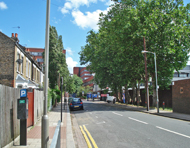
The western main vehicle entrance to St George's Hospital in Cranmer Terrace follows the original line of Tooting Grove. The Fountain Hospital would have been on the left and the Grove on the right.

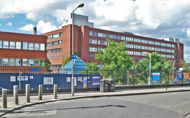 The Lanesborough Wing of the new St George's Hospital, built on the site of the Fountain Hospital, opened in 1980.
The Lanesborough Wing of the new St George's Hospital, built on the site of the Fountain Hospital, opened in 1980.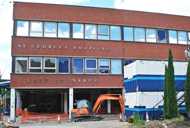
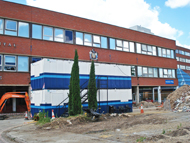
The Grosvenor Wing of St George's Hospital, built on the original line of Tooting Grove, is closed and currently undergoing renovation (July 2008).
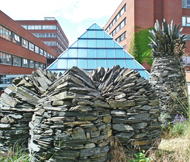
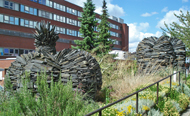
A lovely piece of art work by Peter Randall-Page is located by the entrance to the right of the Grosvenor Wing. Called And Wilderness is Paradise Enough (but more commonly known as 'the Pineapples'), the structures are made from slate assembled using a dry-stone wall technique.
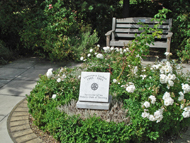
A centenary garden sponsored by the Rotary Club of Tooting in 2005.

Possibly another art work or a cluster of rocks with an incidental wheelchair.
The actual fountain from which the Hospital took its name was also of this design. It was planned to re-erect the fountain on the grass bank outside the administration building of Queen Mary's Hospital, although it is unclear whether this ever happened.
The Fountain Hospital was the first mental hospital to have a League of Friends - the Friends of the Fountain Hospital - from which developed the National Society for Mentally Handicapped Children, today known as Mencap.
http://hansard.millbanksystems.com (1958)
http://hansard.millbanksystems.com (1959)
http://rcnarchive.rcn.org.uk (1899)
http://rcnarchive.rcn.org.uk (January 1952)
http://rcnarchive.rcn.org.uk (August 1952)
http://studymore.org.uk
www.aim25.ac.uk
www.elite-elevators.co.uk
www.stgeorges.nhs.uk
www.workhouses.org.uk
Return to home page